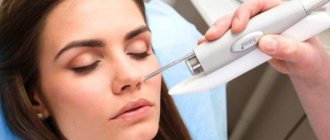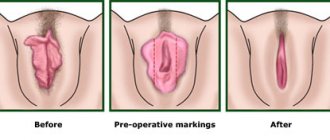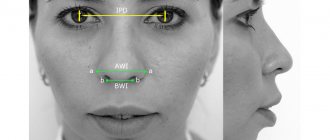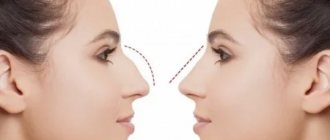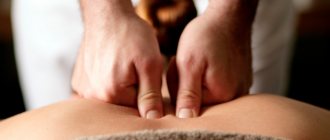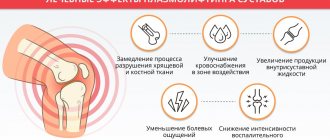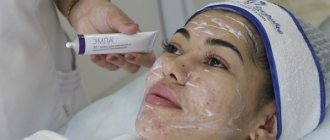Treatment of displaced nasal bone fractures
With multiple fragments, large displacements and fractures, it is not easy to correct the shape of the nose and restore its functionality.
A difficult situation also arises with extensive open injuries, when the skin and adjacent tissues are damaged. In such cases, doctors resort to surgery after a broken nose. Surgical intervention is effective only after the formation of a callus and complete fusion of the bones (usually this occurs no earlier than 6 months after injury). During surgery for a nasal fracture, the surgeon breaks the bones that have grown together in a random manner and restores their correct position. The passages are tightly packed with gauze turundas (cotton balls). After this, stitches can be placed. If, as a result of injury, the bone has broken into several fragments and may disintegrate, then an additional plaster splint is applied on the outside.
The longuet is secured to the nose using an adhesive plaster. Normally, 4–6 days are enough for the bone fragments to heal.
How to straighten your nose yourself
You can straighten your nose without a doctor only in a completely hopeless situation. At the same time, it is necessary to understand that other consequences of TBI and the like may make themselves felt in the near future.
If a visual assessment of the fracture shows that the septum is broken and the nose is sunken, you should not even try to correct the situation without special skills and tools - it is too dangerous and useless.
You can try to eliminate only a small lateral displacement. To do this, you need to cover your nose with ice, after 5-7 minutes, grab the back of your nose with your thumb and forefinger in the place where the displacement is visible, pull first down and then in the direction opposite to the curvature. If the procedure is successful, you will feel your nose move back into place. Try to secure it in this position and use antiseptics.
Types of nasal reposition
Timely implementation of this simple procedure allows you to avoid many unpleasant consequences (constant inflammation of the mucous membrane, difficulty breathing, dullness of smell). Depending on the degree of damage that may be required during this manipulation, there are:
- closed reduction of the nasal bones after displacement. It involves maintaining the integrity of the skin during the procedure.
- open reduction of the nasal bones , where the doctor makes incisions to provide access to the damaged area.
During the entire rehabilitation period (normally about 6 months) after injury and straightening of the nose, after a fracture or displacement of bones, it is necessary to avoid certain actions:
| Action | Cause |
| Taking warming water and solar treatments (hot bath, sauna, sauna, hot compresses on the face, visiting the beach and solarium). | Increased blood pressure and risk of bleeding. |
| Intense sports, significant physical activity. | Rapid breathing creates stress on the post-traumatic area, causing the risk of rupture of the mucous membrane and bleeding. |
| Inclusion of alcohol in the diet, consumption of spices, spicy and hot dishes. | Increased blood circulation, which threatens hemorrhage. |
| Wearing goggles, heavy respiratory protection, diving masks | The load on the fragile nasal septum threatens repeated fracture or displacement of the bones |
Fracture or not
The nose, as the most prominent and fragile part of the face, is the first to suffer when encountering a hard object, surface or an unexpected fist. Nearly 40% of all facial injuries involve fractures of the nasal bones. In this case, damage is caused not only to the appearance, but, what is much more serious, to the functional qualities of the nose - breathing and smell.
The shape of fractures is:
- Open – when the skin is not damaged or the injuries are represented by small abrasions;
- Closed - when the bone structure is visible through large deep tears in the skin, sometimes with bone fragments.
By type of damage:
- Fracture of the nasal septum - the nose noticeably collapses inwards;
- Displaced fracture – the nose is bent and shifted to the side.
If the injury to the nose is not accompanied by bleeding, most likely it is a bruise and applying cold is enough to relieve the swelling.
If observed:
- Copious bleeding;
- Loss of consciousness, state of shock;
- Noticeable hyperemic swelling of the tissues around the eyes and nose, which, after a few hours, acquires a purplish-bluish tint;
- Severe pain when touching the nose and face;
- Visible disruption of the contours of the nose.
Most likely, the integrity of the bones is broken and the nose needs to be realigned after the fracture.
Indications for correction after a nasal fracture
Sometimes damage to the nasal bones causes only pain, swelling, bleeding, and difficulty breathing, but does not make itself known by external changes. It is necessary to correct it if there are the following signs :
- curvature of the nose or the appearance of sunken areas on it;
- unnatural mobility of organ tissues;
- tracing the edges between bone fragments;
- characteristic sound when pressed;
- lacrimation in some cases;
- discharge of light yellow fluid from the nasal passages.
To learn how septoplasty is performed to correct a deviated nasal septum, watch this video:
Surgical treatment is required if additional factors are present:
- More than 2 - 3 weeks have passed since the injury, the nose is deformed;
- the septum is deviated, there is a large hematoma in this area;
- the walls of the nasal sinuses are injured;
- there is damage to the soft tissues of the face.
Surgery to correct the nose can be successfully performed years after the fracture.
Types of fractures, possible actions for realigning the nose
Depending on the location and degree of damage, the following injuries are distinguished:
- fractures of bones and nasal septum;
- violations of the integrity of the walls of the sinuses and cartilage;
- characteristic of children, separation of tissues between the nasal bones or frontal processes without fracture of bones, which are more elastic than in adults;
- hematomas in the nose and under the eyes.
| Fractures of the nasal bones are: | |
| Open and closed | With or without offset |
| A closed fracture without damaging the soft tissue surface is eliminated by manual (external) and instrumental (internal) bone reduction. | A non-displaced fracture leaves the damaged bones in their normal position. The doctor’s task is to fix them until they are completely fused, preventing the possibility of curvature. |
| The open form of the fracture after correction of the nasal bones involves the connection of injured soft tissues with the application of cosmetic sutures. | Displacement of fragments relative to each other due to injury or unsuccessful first aid is eliminated by surgery. After this, a plaster cast is applied and tampons are inserted into the nose to prevent the displaced bones from moving. |
To select a method for eliminating violations (repositioning) of an injured nose, the type of deformation is important. Based on this feature, plastic surgeons distinguish fractures:
- with retraction of the nasal bridge;
- depression inward, which makes the nose visually shorter or wider;
- displacement of bones to the side;
- formation of a hump on the nose.
Differences in the treatment of fresh and old fractures
The specialists at the CONSTANTA Clinic also distinguish between the reduction of fresh nasal fractures , which patients treat immediately after injury, and old ones , when the consequences of a long-standing injury must be corrected. The easiest fracture to correct is one that has occurred within 14 days . When a patient presents in the first days after an injury, surgery may be postponed until the swelling that prevents surgery has subsided. In addition, before it you need to take an x-ray and, if necessary, a tomography of the nose area.
After 2-3 weeks, the process of ossification of injured tissue begins. Due to the loss of mobility of the fragments, returning them to their place becomes difficult and does not guarantee the absence of aesthetic defects (humps or dimples on the bridge of the nose). In this case, the operation must be postponed for several months until the injury has completely healed. Once the bones have healed without medical assistance, nose correction is a more complex and lengthy surgical procedure than treating a fresh fracture.
If you do not contact immediately after injury
Failure to visit a doctor on time will result in the bone healing incorrectly in a fairly short time. And her situation will have to be corrected only in six months. This is done through surgery. First, the bone is broken, then placed in the correct position, ensuring normal fusion. This process is more complex than reducing a fresh fracture.
- Pain in the Foot After a Fracture: Causes + Remedies
And all the time before the operation, the patient will have to see in the mirror a nose that has shifted to the side or a dent or hump that has formed on it. But the main consequence of an untreated fracture is breathing problems. They can appear even if there are no external signs of the trauma.
We recommend reading about correcting a deviated nasal septum using rhinoplasty and septoplasty. You will learn about the causes and types of deformation, their diagnosis, the need for correction, preparation and implementation of procedures, and their features. And here is more information about rehabilitation after rhinoplasty.
Collateral hazards of fracture
Despite its fragility, a light breeze cannot break the nose. Therefore, a blow capable of breaking the bones of the nose almost always simultaneously causes injury to the brain. TBI is dangerous both due to ongoing disorders in brain structures and delayed complications. Sometimes nasal trauma is supplemented by jaw fractures, disruption of the nasolacrimal ducts and cribriform plate. The latter can cause various inflammatory processes in the brain.
To avoid negative consequences, you should contact specialists as soon as possible.
When the nose was not realigned or the nose was corrected after a fracture at home, complications often follow the injury:
- Deviated nasal septum – the patient’s healthy nasal breathing is disrupted, sinusitis and rhinitis develop;
- Hematoma of the nasal septum - without timely treatment can lead to suppuration and destruction of cartilage.
Main reasons
The bones of the nose have a rather fragile structure and are often damaged by injury. Most often, this pathology occurs in boys under the age of twelve.
When injuries occur in the nasal area, the following structures break:
- external nasal bones;
- orbital walls;
- frontal processes;
- vomer;
- turbinates.
Trauma occurs when struck by a sharp or blunt object, but the mechanisms vary. The force and direction of the mechanical action play a decisive role. According to the mechanism of injury, injuries are:
- open with soft tissue damage;
- closed, the integrity of the skin, muscles and mucous membranes in the fracture zone is maintained;
- with displacement of bone fragments;
- impacted with deformation of the septum.
The bridge of the nose may fall inward if the fracture is combined with damage to the nasal septum. There are also unilateral and bilateral fractures.
There are the following options for injury to nasal structures:
- Lateral impact - in this case, the effect is on one of the side walls, which is directed transversely and does not coincide with its longitudinal plane. With this impact, a fracture occurs with the walls pressed into the organ cavity. Fragments of the septum move away in the direction of the impact force. Then the opposite wall is damaged. As a result, the patient develops a lateral fracture. (Figure 1.)
- When the force propagates from front to back, the impact falls on the front plane. A fracture of the nasal bones occurs in the area of bone sutures at the junction with the processes of the frontal bone and the bones of the upper jaw. Opener damage often occurs. At the site of damage, a saddle-shaped flattening of the back is formed. (Figure 2.)
The surgeon’s tactics, as well as the technique used to straighten the nose after a fracture, depend on the type of fracture.
The reasons why nasal bone fractures occur are quite varied.
These include:
- road accident;
- injuries during sports;
- work injuries;
- fights;
- injuries during military operations and exercises;
- damage at home;
- fainting.
Rarely, damage to the facial bones occurs during an epileptic seizure.
Injuries to the nasal bones are often combined with other injuries to the bone structures and soft tissues of the face. This is reflected in the surgical techniques used for nasal fractures.
Reposition of nasal bones in a child
In a child, tissue regeneration occurs faster. The bones heal within four weeks. In children, due to good blood supply to the tissues, the pharyngeal mucosa quickly swells, which interferes with normal breathing. In case of injury, you should immediately go to the emergency room. For mild fractures, only anterior tamponade is often performed. The doctor inserts special tampons into the baby's nasal passages. They lift and return displaced bone fragments to their place. For a fracture with significant displacement to the side in children, only the finger technique is used. The surgeon, without using instruments, uses his hands to return the fragments to their original place. An elevator for repositioning a child is used only for fractures with a large number of fragments and displacement of the back into the nasal cavity. With its help, bone fragments are lifted and returned to their original place. Fixing a broken nose in children is a rather painful procedure. It is often performed under general anesthesia.
Symptoms of curvature
Various degrees of curvature of the septum or other structures of the nose are typical for 90% of people; for the majority they do not cause any discomfort or cause symptoms. With severe deformities, various symptoms will be present, which are noted by the patient himself or his relatives. These include:
- visually incorrect shape of the nose or part of it;
- headache;
- persistent nasal congestion or runny nose;
- night snoring, possibly with attacks of sleep apnea (prolonged stops in breathing);
- cough and sore throat;
- earache;
- frequent colds.
Often the problem is first identified by a doctor during an examination for various diseases of the nasopharynx or middle ear.
Types of nasal deformities
Most often, nasal deformities occur in the area of the external structures or tissues that form the nasal septum. There may be problems such as asymmetry of the wings of the nose, curvature of the back or anomalies in the structure of the tip, violation of proportions. In addition, the nostrils may be asymmetrical, which is clearly visible when the head is thrown back.
Another problem is violations in the location and structure of the septum. Various topographic deviations are possible, which are divided into categories. ENT doctors and plastic surgeons separately distinguish:
- horizontal curvature;
- vertical deformations;
- partial curvature;
- complete curvature;
- damage to the anterior or posterior sections;
- s- or c-shaped deviation;
- the appearance of spines or ridges on the septum.
Deviated nasal septum - how to correct the violation yourself without surgery
How to correct a deviated nasal septum
An increasing number of people in the modern world choose an active, healthy lifestyle, paying attention to sports: jogging, fitness, various sports games, as well as yoga.
This information is especially relevant for those who practice yoga: breathing techniques and, especially, pranayama. Breathing determines the quality of our life. The functioning of the body and all its systems depends on how we breathe. For a harmonious state of the body, for health and normal energy circulation, it is necessary to breathe through the nose: in cold weather, the nose warms the air, in hot weather it cools and moisturizes. Also, the nose is a kind of “filter” that purifies the inhaled air. When regularly practicing yoga or sports with a crooked nasal septum, the indicators of a person’s physical condition worsen. Therefore, it is very important to pay attention to the breathing process: after all, if breathing is incorrect, the body will not receive additional oxygen during intense exercise.
In this article, we will tell you why deviated septums occur, what symptoms are present with this pathology, and share one technique that can correct it.
Why does a deviated nasal septum occur in an adult?
A deviated septum is its deviation to the right or left from the midline, as a result of which the breathing process and the flow of oxygen into the human body are disrupted. According to statistics, more than 60% of the world's population suffers from curvature. Quite often it happens that a person ignores this problem for years because it is not pronounced. After some time, the body gets used to the fact that there is not enough oxygen, but the quality of life decreases noticeably, because this is a constant discomfort for the body. This affects not only physiological processes, but also the psycho-emotional state.
The main causes of a deviated septum
- Deformations caused by trauma (broken nasal septum)
- Physiological disorders: uneven tissue growth in the nasal cavity from birth
- curvature due to diseases: poor absorption of calcium, softening of bone tissue, insufficient formation. For example, rickets.
Symptoms of a deviated nasal septum
- Difficulty breathing through one of the nostrils (observed on an ongoing basis)
- Frequent inflammation of the paranasal sinuses (inflammation of the nasal mucosa)
- Snore
- Dryness in the nasal and oral cavities: disruption of air humidification processes.
Consequences of a deviated nasal septum due to insufficient oxygen supply
- Weakness, drowsiness and increased fatigue due to insufficient oxygen supply to the body
- Decreased concentration
- Headache
- Deterioration in physical performance during exercise
- Increased likelihood of depression
- Deterioration in the functioning of internal organs
- Deterioration of recovery processes during sleep
- Increased intracranial pressure
- Deterioration of concentration and memory.
How to correct a deviated nasal septum at home
First of all, you need to see a doctor who can prescribe proper treatment. This is important in order to understand in which direction the displacement occurred and how intense it was. Outwardly, a person may not appear to have a deviated septum because they have a straight nose, but they may have a broken nasal septum from an injury sustained in early childhood. Also, if the nose is injured, they can “put” the bridge of the nose in place, but this does not mean that the septum has also been put in place.
After this, there are two options: either have surgery to straighten the crooked bridge of the nose, or use the method we will share below to correct the misalignment at home. Separately, we note that we are sharing this information for those who, for some reason, cannot/do not want to have surgery, and want to try to resolve the issue on their own. The method does not completely remove the curvature, but it will correct the condition quite effectively. Also, this method may be relevant for those who practice hatha yoga, in particular pranayama and asanas.
Pranayama and deviated septum
By studying ancient texts about hatha yoga, you can see how important the practice of performing breathing exercises - pranayamas - is. First of all, this is due to the energetic aspects of yoga: for a harmonious state of a person, you need to cleanse the energy channels - Ida and Pingala. Considering that these channels (nadis) originate in the nostrils (right nostril - Pingala, left nostril - Ida), the nose should breathe freely and easily. For all yoga breathing techniques, an important point is uniform breathing through the left and right nostrils, which can only be achieved with a straight nasal septum.
Even with a slight curvature of the nasal septum, this becomes impossible, and insufficiently correct implementation of pranayamas can do more harm than good. Therefore, before you start practicing pranayama, pay attention to the condition of your nasal septum and how exactly your nose breathes.
Anuloma-viloma pranayama with deviated nasal septum
Anuloma-viloma pranayama involves alternate breathing through the right and left nostril. If there is a displacement of the nasal septum, air will flow through one nostril with difficulty. Therefore, before starting to perform this breathing technique (and a similar one - “Nadi Shodhana Pranayama”), it is necessary to restore the patency of the nostril.
Techniques for correcting the nasal septum without surgery
So, how can you straighten your nasal septum without surgery? Before directly straightening the curvature, it is necessary to clear the nasal cavity of mucus. First of all, I would like to pay attention to the cleansing techniques (shatkarmas) of the nose described in treatises on hatha yoga. Yoga offers several shatkarmas that can be helpful in this matter. One of them is called jala neti (cleansing the nose with water).
What you will need:
- A special kettle with a suitable nozzle for the size of the nostril
- Salty water.
How to do it correctly:
- Hold the salt water container with one hand
- Gently insert the tip of the spout into the right nostril and slowly tilt your head to the left
- Allow water to flow into your left nostril and out through your right
- It's okay if water gets into your throat, the most important thing is to continue pouring water for 10-20 seconds
- Remove the teapot spout from your nostril, pinch your left nostril and exhale through your right nostril without sudden movements, getting rid of excess water and impurities
- Repeat the procedure identically for the left nostril.
- At the end of the procedure, you need to dry your nose, perform kapalabhati pranayama through the left and right nostrils alternately, and then through both nostrils
This yoga technique for cleansing the nasal cavity works very effectively when the nasal septum is displaced. For adults, this procedure will not cause difficulties.
Next, we will talk about the second important nasal cleansing technique in yoga, which is called “sutra-neti” (cleansing the nose using a special catheter).
What you will need:
- Special catheter (preferably 4 mm in diameter)
- Oil.
How to do it correctly:
- Disinfect the catheter and lubricate it with vegetable oil to make it easier to enter the nasal cavity
- Sit in a comfortable position and completely relax, breathe through your mouth
- With your head slightly tilted back, slowly insert the catheter into one of your nostrils. This should be done gradually, twisting it so that it fits into the hole easier.
- Push the catheter in until you feel it in your throat. Then gently grab the tip with your fingers and pull it out through your mouth.
- Move the catheter back and forth several times to clear the nasal cavity.
- If the first time you perform the procedure you feel a strong tickling in your nose, it’s okay, over time you will get used to the unusual sensations
After completing the procedure, be sure to perform Jala Neti to get rid of all mucus discharge from the nose. This procedure will not straighten the nose, but will help stretch the inner cavity of the nose so that air can pass freely.
So, we are gradually moving directly to the technique of correcting a deviated nasal septum at home . We recommend this procedure be performed only by adults who, for some reason, have injured their nose, leading to a deviated septum or fracture. If the curvature occurs for other reasons (for example, illness), it is better to consult a doctor. We offer this practice solely as a recommendation; if you have any concerns, it is better to consult a doctor.
What you will need:
- Tonometer cord (30-40 cm)
- Rubber bulb from a tonometer
- Two fingertips
- Threads.
How to do it correctly:
- Connect the cord and the rubber bulb from the tonometer, and put two finger guards on the end of the cord (use thread to hold them tightly)
- Insert the cord with finger tips into one nostril, as deep as possible
- Slowly “pump” the fingertip with air using a rubber bulb. Hold the inflated fingertip in your nose for 3-5 minutes
- The fingertip inside the nose begins to inflate and adjust the nasal septum using pressure
- This procedure may not feel very pleasant, but it should not be sharply painful.
- You can do it every day or every other day for two weeks.
Literally after the first procedure, you can feel an improvement in the quality of your breathing by 50-80%. We share our personal experience, this method has helped many yoga practitioners increase air flow into the nasal cavity and correct the curvature by 90%. However, we recommend performing these techniques under the supervision of a specialist before you decide to try them yourself.
Treatment and rehabilitation after reposition
Fixing a broken nose is often not enough; recovery requires treatment of the patient and subsequent rehabilitation. The final healing of a broken nose occurs up to three months after the injury. In case of open fractures and serious damage to soft tissues, the doctor prescribes antibacterial drugs to the patient, taking into account data from testing the sensitivity of the bacterial flora to antibiotics.
The patient undergoes the following procedures:
- The patient, after the broken nose has been fixed, undergoes physical therapy to speed up recovery. Infrared irradiation is often used. It increases blood supply to the area of damaged bones, promoting rapid tissue restoration. The course lasts no more than fifteen procedures, with a total duration of twenty minutes.
- Electrophoresis is widely used to deliver nutrients and microelements to damaged tissues in the deep layers.
- UHF is prescribed to the patient to relieve swelling and inflammation of the soft tissues of the nose.
After the operation, the patient is prohibited from sleeping on his side and stomach to prevent additional trauma to the reduced nose. It is forbidden to wear glasses, they put pressure on the back. It is not recommended to engage in active sports during the entire recovery period. Visiting the sauna and bathhouse is not recommended, as this increases blood supply to the facial area and increases swelling.
Possible complications
If fractures of the nasal bones are treated incorrectly or the patient seeks medical help late, complications arise.
These include the following adverse effects:
- A deviated nasal septum is common. It leads to impaired nasal breathing and the formation of chronic rhinitis. A focus of chronic infection appears in the nasal cavity and nasopharynx. It can provoke the occurrence of a purulent process in the body at any time.
- Visible deformation of the nose occurs with severely displaced injuries. It always accompanies a deviated nasal septum and is complicated by the development of chronic inflammation of the nasal mucosa.
- Subcutaneous hematomas and bleeding occur both immediately after injury and in the long-term period. It stops during internal and external tamponade.
- Infection occurs when bacteria enters the wound. The inflammatory process increases. As a result, it develops not only in soft tissues, but the infection penetrates into the nasal sinuses. Sinusitis, frontal sinusitis and ethmoiditis develop.
- After injuries to the nose, scar changes and synechiae of the nasal cavity sometimes form. They disrupt nasal breathing and reduce the sense of smell.
When a fracture of the nasal bones is combined with damage to the skull, the patient develops severe neurological symptoms. This causes disability.
